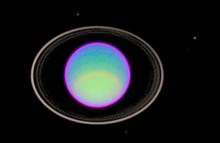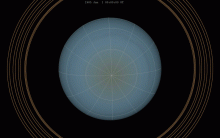Listen to today's episode of StarDate on the web the same day it airs in high-quality streaming audio without any extra ads or announcements. Choose a $8 one-month pass, or listen every day for a year for just $30.
You are here
Uranus at Opposition
The planet Uranus is putting in its best appearance of the year this week. It rises at sunset and remains in the sky all night. It’s also closest to us for the year, at less than 1.8 billion miles, so it shines brightest. In fact, under especially dark skies, for those with very good vision, it’s barely visible to the unaided eye. Most of us, though, need binoculars to find it.
Uranus is one of the giants of the solar system — only Jupiter and Saturn are bigger. But Uranus may be put together differently from its larger siblings.
Jupiter and Saturn are balls of hydrogen and helium wrapped around solid cores. Uranus probably has a solid core, too, but it has a lot less hydrogen and helium.
All of those elements that it does have are contained in an atmosphere that’s perhaps 3,000 miles thick — about one-fifth of the distance down from the tops of the planet’s clouds.
Below that may be a liquid or partially frozen mixture of water, methane, and rocky minerals. Unlike the boundary between the oceans and air here on Earth, though, there probably isn’t a sharp boundary between the layers of Uranus. The pressure is so great that the liquid and gas merge in a slushy transition zone.
Uranus climbs into view in the southeast an hour or two after sunset, near the eastern edge of the constellation Pisces. Through binoculars, it looks like a faint blue-green star — a giant world far from the Sun.
We’ll have more about Uranus tomorrow.
Script by Damond Benningfield






